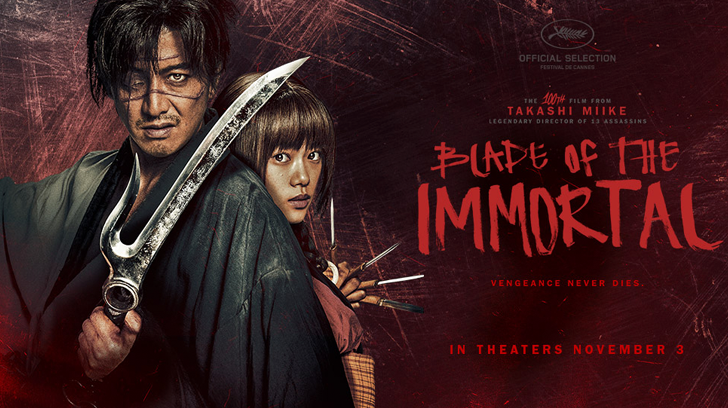
BLADE OF THE IMMORTAL (Japan, dir. Takashi Miike)
After a cruel bounty hunter kills Machi (Hana Sugisaki), young sister of exiled samurai Manji (Takuya Kimura), Manji slaughters the man’s entire gang as revenge but suffers mortal wounds himself. As he is dying on the battlefield, a mysterious witch appears and grants Manji a dubious gift: immortality in the form of “bloodworms” that live in his body and quickly heal him whenever he is injured. Fifty years later, Rin (also Sugisaki) seeks out Manji to hire as a mercenary to take revenge for the death of her parents at the hands of Anotsu (Sôta Fukushi). Manji soon finds himself at war with Anotsu, who has embarked on a campaign to destroy the martial arts schools of the land and is determined to put an end to Manji’s meddling at any cost. Based on a popular manga, BLADE OF THE IMMORTAL is legendary director Takashi Miike’s 100th feature film and its scope is appropriately epic. The body count is easily in the hundreds as Manji slices his way through armies of men in protracted fight scenes, one of which ends with a literal river of blood flowing through the battlefield. Stylistically, the film resembles the relatively restrained period films Miike was making a few years ago like 13 ASSASSINS and HARA-KIRI with a shot of the insane comic book violence for which he will probably always be best known. It’s packed with wild fights, gory action, weird characters, and dark humor–in other words, the things you hope to see in a Miike film. Here’s to 100 more!
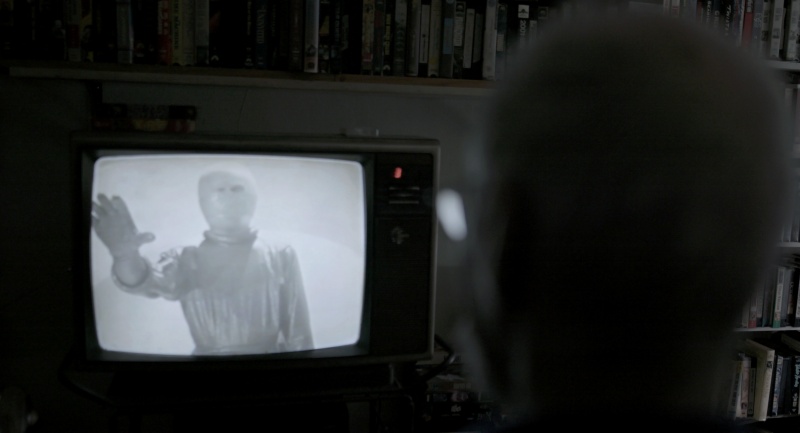
LOVE AND SAUCERS (USA, dir. Brad Abrahams)
David Huggins claims that he lost his virginity to an alien named Crescent when he was 17 years old. This was not the first time he had encountered extraterrestrials, and it was far from the last. Huggins became an artist and has painted numerous scenes related to his experiences with the alien beings, some of them of a sexual nature. Now 72, Huggins lives in Hoboken and works part-time at a deli. LOVE AND SAUCERS is a warm and fascinating documentary about Huggins, his experiences, and his art. He describes his encounters with aliens in a completely matter-of-fact way, likely developed over a lifetime of having people react to him with disbelief. Director Brad Abrahams lets Huggins speak at length, and also talks to his friends and family, all of whom clearly love and respect him even if they don’t quite know what to make of his stories. It’s a fascinating look at a man who has a singular artistic vision, to say the least, and it raises interesting questions about belief and empathy. And, of course, aliens.
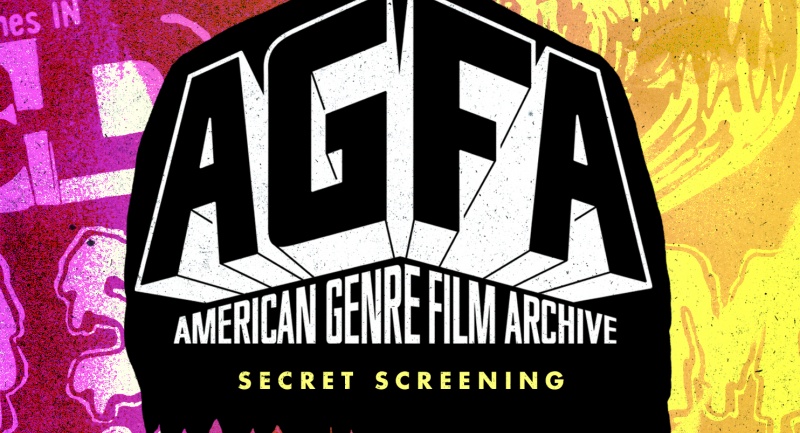
TAKE IT OUT IN TRADE (USA, 1970, dir. Edward D. Wood, Jr.)
The American Genre Film Archive (AGFA) and Something Weird Video (SWV) presented this film as a secret screening, and they managed to keep the secret all the way up until AGFA’s Joseph Ziemba and Lisa Petrucci of SWV gave a lengthy, thorough introduction to the film. Long thought lost, TAKE IT OUT IN TRADE was made when Ed Wood was transitioning to making hardcore sex films in the 1970s. Unlike those later films, though, this one has much more in common with the “nudie cuties” that were popular in the early 1960s–lots of groan-worthy dad jokes and puns, a goofy lead character mugging at the camera while endlessly peeping on nude women, wacky music, etc.–than the increasingly explicit adult films of the ’70s. The only thing that really stands out as far as content goes is a few simulated sex scenes, one heterosexual (in which neither party is ever completely nude) and a few lesbian scenes (with explicit nudity but no “hardcore” shots). The setup follows detective Mac McGregor (Michael Donovan O’Donnell) who has been hired by a Los Angeles family to find their daughter, who has left home and set up shop at Penny’s, a popular brothel across town. He uses the expense account for the job to travel all over the world and peep on ladies in far-flung lands before finally coming back to find the young woman by working his contacts. These include drag queen Alecia (played by Wood himself!) and a happily married androgynous couple of indeterminate gender. The fact that neither Wood’s character nor the couple are played for jokes makes TAKE IT OUT IN TRADE feel weirdly progressive for a 70s sexploitation film, which makes sense given Wood had more or less free reign to do whatever he wanted. This would sadly be the last time he had such latitude, as following this he went on to make hardcore cheapies like NECROMANIA and THE YOUNG MARRIEDS for hire. While it may be frequently very dull (a problem inherent to nearly all “nudie cuties”), there’s no question that AGFA and SWV’s discovery and restoration of TAKE IT OUT IN TRADE is hugely important and fills in a crucial missing piece of cult/exploitation film history.

GERALD’S GAME (USA, dir. Mike Flanagan)
With their marriage on the rocks, Jessie (Carla Gugino) and Gerald (Bruce Greenwood) head to their remote Summer house for a weekend to spice things up. Unfortunately Gerald’s idea of just how to do that is very different from Jessie’s, and includes handcuffing her to the sturdy wooden posts of their bed. Even more unfortunately, Gerald keels over from a heart attack and tumbles to the floor, leaving Jessie shackled to the bed with no one coming to the house for weeks and no neighbors for miles. Jessie must confront a long-buried horror from her childhood in order to find the strength to free herself both physically and emotionally from the trauma that has unconsciously shaped her entire life. GERALD’S GAME is a deft, ingenious adaptation of Stephen King’s novel from director/co-writer Mike Flanagan (OCULUS) and his longtime screenwriting partner Jeff Howard. Carla Gugino gives an incredible, fearless performance. She’s on-screen for nearly every frame of the film, which like the novel on which it’s based is set largely in one room. It’s tense and scary even before a single gruesome effect late in the film that makes an indelible impression–even the Fantastic Fest audience, veterans of all manner of horrors, had a hard time watching it. Nothing here is gratuitous, though, and despite the weird tonal shift at the end (which is directly from the book) there’s also nothing that doesn’t need to be here. This is one of the best Stephen King adaptations ever made, and certainly one of the best genre films of the year.
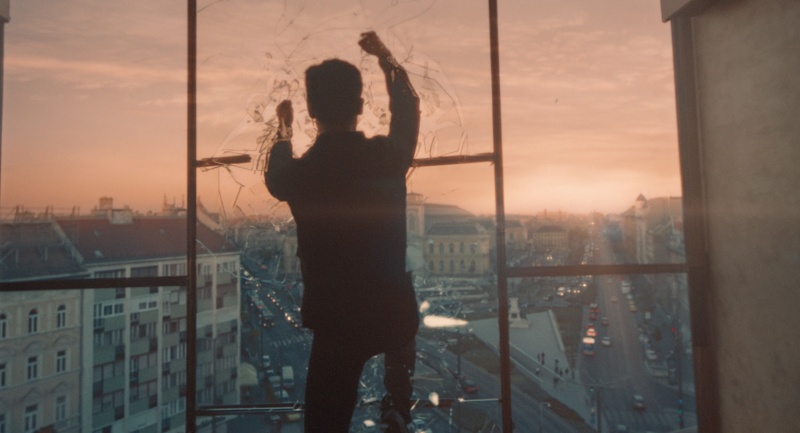
JUPITER’S MOON (Hungary, dir. Kornél Mundruczó)
Aryan (Zsombor Jéger) is traveling with his father from Serbia in hopes of finding refuge in Hungary, but during their illegal border crossing a firefight breaks out and Aryan loses track of his father in the confusion. A panicked police officer shoots Aryan and then flees before the wounded Aryan is mysteriously lifted into the air. After a crash landing, Aryan makes his way to the facility where his fellow illegals are being held and meets Dr. Gabor Stern (Merab Ninidze). Stern runs a sideline helping illegals give police the slip through the hospital where he works, but when he sees Aryan’s power he gets an idea for a much better grift. Aryan just wants to find his father, but with the police closing in and a terrorist plot in motion, even his newfound abilities may not be enough to save him. JUPITER’S MOON is Kornél Mundruczó’s follow-up to his international breakthrough WHITE GOD, and it similarly blends a prosaic world and characters with fantastic events. The scenes of Aryan exercising his powers are a stark contrast to most “superhero” movies. He floats quietly, limbs swaying as though in water, with a look of calm. These inventively staged scenes are lyrical and meditative for the most part, although in one case he uses his ability to intimidate a skinhead to surprising effect. Jéger gives a powerful lead performance and Mónika Balsai, star of LIZA THE FOX-FAIRY, appears in an excellent supporting role as Dr. Stern’s long-suffering lover. As beautiful and elegiac as it is, though, there is a glaring issue at the film’s core: Merab Ninidze’s voice is dubbed by another actor, András Bálint, and the effect is jarring. When Stern is speaking English, it’s not a problem, but whenever he’s speaking Hungarian, there is an extremely distracting disconnect between his words and his mouth. It’s an odd problem for a film that is otherwise excellent, and sadly detracts quite a bit from the experience.

ANYAB (Egypt, dir. Mohammed Shebl)
A young couple’s car breaks down on a dark and stormy night, and they make their way to the closest house. It just so happens to be a castle where a weird, wild party is underway, held by the vampiric owner of the estate. Also, the story frequently cuts to a guy in a room with a bunch of books commenting on the action. If this sounds familiar, it’s because ANYAB is an Egyptian riff on THE ROCKY HORROR PICTURE SHOW, which it mimics faithfully for a good chunk of its running time. There are some incredible costumes and catchy songs in the first act, but the film takes a hard turn away from its source material in the middle to show how capitalism breeds “vampires” everywhere. A vignette plays showing somebody ripping off somebody else, they turn to the camera to show off their plastic fangs, cut to the professor in his library laughing maniacally, repeat. This section of the film seems to go on for a solid twenty to thirty minutes, and after a while the repetition is both exhausting and maddening. Things pick up in the final act, and overall ANYAB is a super fun curiosity, but that middle drags badly. Still well worth a look for the songs and costumes alone, though, and anyone so inclined to track it down will likely find it a rewardingly strange viewing.
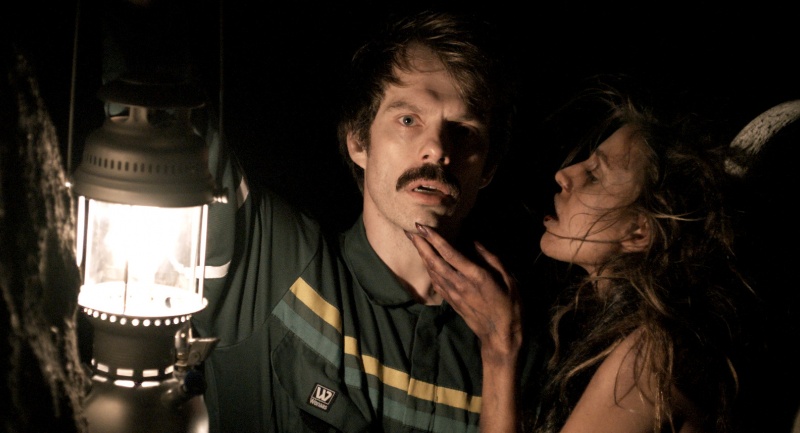
VIDAR THE VAMPIRE (Norway, dir. Thomas Aske Berg & Fredrik Waldeland)
Vidar (co-writer/co-director Thomas Aske Berg) lives with his overbearing devout Christian mother Kristin (Marit Sanden) on the farm where he grew up. He’s miserable, and just wants to experience life outside the church and his small town. Most specifically, he wants to get laid. In the depths of his despair Vidar is approached by Jesus (Brigt Skrettingland), who offers Vidar a way to fulfill all his dreams. Jesus can turn Vidar into a vampire like himself and show him the ropes of eternal depravity, and all Vidar has to do is let Jesus orally violate him first. VIDAR THE VAMPIRE is a horror/comedy with a lot of interesting ideas that it frustratingly does very little to explore beyond surface shock. The implications of Jesus being an amoral vampire are never really addressed, he just sort of shows up from time to time to say awful stuff and help coax Vidar into doing terrible things. At one point (during a deeply awkward AA meeting Vidar crashes), a suggestion is made that Jesus and Satan are one and the same in a casually tossed-off observation that is never addressed again. There are some inspired visuals in the film, most notably Vidar rising from the coffin at his own funeral to terrorize the mourners who never cared much for him anyway. But too often VIDAR THE VAMPIRE opts for easy, lazy lowest common denominator jokes when its setup feels perfectly tailored to more thoughtful satire.
- [CINEPOCALYPSE 2017] FIVE FILMS YOU CAN’T MISS AT CINEPOCALYPSE! - October 31, 2017
- Hop into Jason’s Ride for a Look at the Wild World of Vansploitation! - August 11, 2014
Tags: Aliens, American Genre Film Archive, Austin, Brad Abrahams, Bruce Greenwood, Carla Gugino, Ed Wood, Egypt, Fantastic Fest, Hungary, japan, Mike Flanagan, Norway, Something Weird Video, Stephen King, Takashi Miike

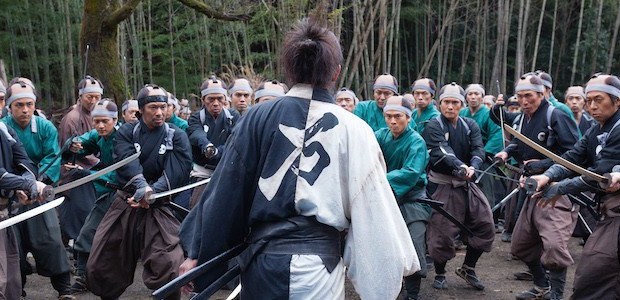




No Comments